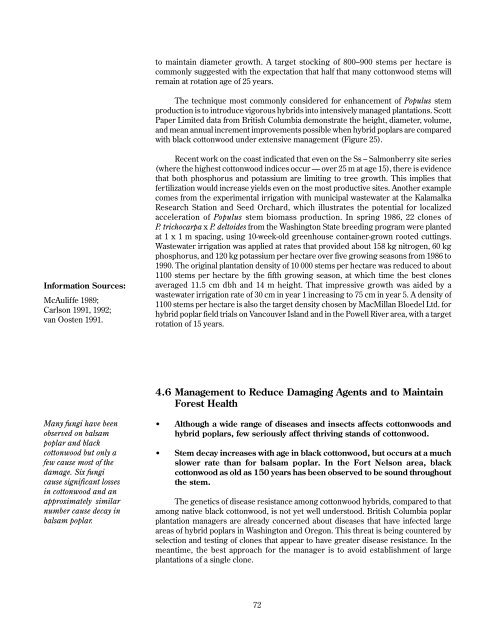FRDA Report: Black Cottonwood and Balsam Poplar Managers ...
FRDA Report: Black Cottonwood and Balsam Poplar Managers ...
FRDA Report: Black Cottonwood and Balsam Poplar Managers ...
Create successful ePaper yourself
Turn your PDF publications into a flip-book with our unique Google optimized e-Paper software.
Information Sources:<br />
McAuliffe 1989;<br />
Carlson 1991, 1992;<br />
van Oosten 1991.<br />
Many fungi have been<br />
observed on balsam<br />
poplar <strong>and</strong> black<br />
cottonwood but only a<br />
few␣ cause most of the<br />
damage. Six fungi<br />
cause␣ significant losses<br />
in␣ cottonwood <strong>and</strong> an<br />
approximately similar<br />
number cause decay in<br />
balsam poplar.<br />
to maintain diameter growth. A target stocking of 800–900 stems per hectare is<br />
commonly suggested with the expectation that half that many cottonwood stems will<br />
remain at rotation age of 25 years.<br />
The technique most commonly considered for enhancement of Populus stem<br />
production is to introduce vigorous hybrids into intensively managed plantations. Scott<br />
Paper Limited data from British Columbia demonstrate the height, diameter, volume,<br />
<strong>and</strong> mean annual increment improvements possible when hybrid poplars are compared<br />
with black cottonwood under extensive management (Figure 25).<br />
Recent work on the coast indicated that even on the Ss – Salmonberry site series<br />
(where the highest cottonwood indices occur — over 25 m at age 15), there is evidence<br />
that both phosphorus <strong>and</strong> potassium are limiting to tree growth. This implies that<br />
fertilization would increase yields even on the most productive sites. Another example<br />
comes from the experimental irrigation with municipal wastewater at the Kalamalka<br />
Research Station <strong>and</strong> Seed Orchard, which illustrates the potential for localized<br />
acceleration of Populus stem biomass production. In spring 1986, 22 clones of<br />
P.␣ trichocarpa x P. deltoides from the Washington State breeding program were planted<br />
at 1 x 1 m spacing, using 10-week-old greenhouse container-grown rooted cuttings.<br />
Wastewater irrigation was applied at rates that provided about 158 kg nitrogen, 60 kg<br />
phosphorus, <strong>and</strong> 120 kg potassium per hectare over five growing seasons from 1986 to<br />
1990. The original plantation density of 10 000 stems per hectare was reduced to about<br />
1100 stems per hectare by the fifth growing season, at which time the best clones<br />
averaged 11.5 cm dbh <strong>and</strong> 14 m height. That impressive growth was aided by a<br />
wastewater irrigation rate of 30 cm in year 1 increasing to 75 cm in year 5. A density of<br />
1100 stems per hectare is also the target density chosen by MacMillan Bloedel Ltd. for<br />
hybrid poplar field trials on Vancouver Isl<strong>and</strong> <strong>and</strong> in the Powell River area, with a target<br />
rotation of 15 years.<br />
4.6 Management to Reduce Damaging Agents <strong>and</strong> to Maintain<br />
Forest Health<br />
• Although a wide range of diseases <strong>and</strong> insects affects cottonwoods <strong>and</strong><br />
hybrid poplars, few seriously affect thriving st<strong>and</strong>s of cottonwood.<br />
• Stem decay increases with age in black cottonwood, but occurs at a much<br />
slower rate than for balsam poplar. In the Fort Nelson area, black<br />
cottonwood as old as 150 years has been observed to be sound throughout<br />
the stem.<br />
The genetics of disease resistance among cottonwood hybrids, compared to that<br />
among native black cottonwood, is not yet well understood. British Columbia poplar<br />
plantation managers are already concerned about diseases that have infected large<br />
areas of hybrid poplars in Washington <strong>and</strong> Oregon. This threat is being countered by<br />
selection <strong>and</strong> testing of clones that appear to have greater disease resistance. In the<br />
meantime, the best approach for the manager is to avoid establishment of large<br />
plantations of a single clone.<br />
72

















